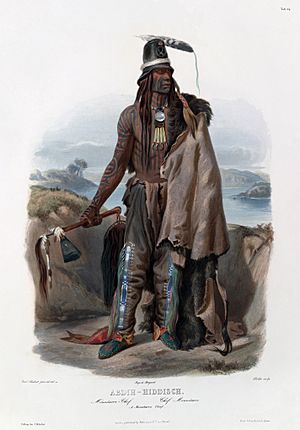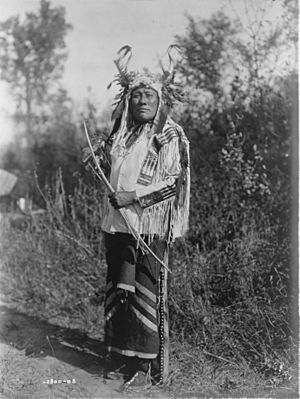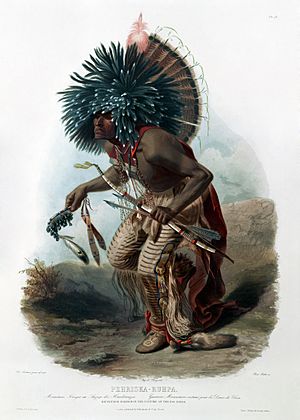Hidatsa facts for kids
The Hidatsa are a Native American group who speak a language related to Siouan languages. Today, they are part of the Three Affiliated Tribes in North Dakota. This means the U.S. government officially recognizes them as a tribe. Their language is similar to the Crow people's language. Some people even think the Hidatsa were the original group from which the modern Crow tribe came.
Contents
What's in a Name?
The Hidatsa call themselves Hiraacá. This name might come from a word meaning "willow tree," but it's not totally clear. The name Hidatsa used to belong to just one of their three main villages. When these villages joined together, they decided to use "Hidatsa" for the whole tribe.
Their friends, the Mandan people, called them Minnetaree. Other tribes, like the Assiniboine, had different names for them too. Sometimes, the Hidatsa were confused with another group called the Gros Ventre. To tell them apart, people called the Hidatsa "Minnetarees of the Missouri" because they lived near the Missouri River.
A Look Back: Hidatsa History
Early Days Until 1850
For many hundreds of years, the Hidatsa and their ancestors lived near the Knife River in North Dakota. Their first villages were built as far back as the 1200s.
In the early 1700s, there were three main Hidatsa village groups. These groups had their own stories and spoke slightly different versions of the language. They only truly became one tribe after they all settled near the Missouri River.
The Awaxawi group believed they came from the Earth, rising up from Devil's Lake. They later moved west and lived near the Mandan people.
The Awatixa group believed they came from the sky. Their stories say they were created near a place called Painted Woods. They always lived between the Heart River and Knife River.
The Hidatsa proper (or Hiraacá) were the largest group. They were many smaller groups who came from the north. They first settled near Devil's Lake. There, they met the Mandan people. They then moved west and settled near the Mandan, learning how to farm and live in permanent villages.
The Hidatsa originally lived near Devil's Lake. But the Lakota people pushed them southwest. As they moved, the Hidatsa met the Mandan people. They became allies and shared the land along the rivers.
Before a big sickness in 1782, the Hidatsa didn't have many enemies. They hunted along the Missouri River. They were strong enough to fight off attacks from the Assiniboine people. Around 1790, the Sioux tribe attacked a large Hidatsa village. The Hidatsa fought back and won a big victory.
The Hidatsa villages were important trading centers. They grew extra food and made crafts. This made them a hub for trade with many other tribes like the Cree, Crow, and Cheyenne. White traders also started visiting in the 1790s.
In 1800, a group of Hidatsa captured Sacagawea and other girls from the Shoshone tribe. Sacagawea was brought to a Hidatsa village. In 1804, the Lewis and Clark explorers met the Hidatsa at their villages near the Knife River.
In 1825, the Hidatsa signed a peace treaty with the United States. They agreed to be friends with the U.S. government. The Hidatsa always kept this promise. They never fought against the United States Army.
Two famous artists, George Catlin and Karl Bodmer, visited the Hidatsa in the 1830s. They painted pictures and wrote about the Hidatsa and Mandan ways of life. Their work shows how these tribes were changing as more settlers arrived and new diseases spread.
In 1837-1838, a terrible smallpox sickness greatly reduced the Hidatsa population to about 500 people. The remaining Hidatsa and Mandan people joined together. In 1845, they moved further up the Missouri River to escape attacks from the Sioux. They settled at a place called Like-a-Fishhook Village. Later, the Arikara people joined them there in 1862.
From 1851 to 1900
The Hidatsa tribe was part of the Fort Laramie Treaty in 1851. This treaty gave them land north of the Heart River. However, the Lakota tribe often took over parts of this land.
In 1861, a brave Hidatsa war chief named Four Bears was killed by attacking Yankton Sioux. In 1862, some Sioux also burned parts of Like-a-Fishhook Village. These attacks made the Three Tribes ask the U.S. Army for help.
The Hidatsa also fought back, sometimes raiding Lakota lands. Around 1870, some Hidatsa, led by Crow Flies High, left Like-a-Fishhook Village. They built a new village near a military post called Fort Buford for protection. They lived as non-reservation Indians until 1894.
The Three Tribes sold some of their land to the U.S. government in 1870 and again in 1886. Later, the tribes won a court case and received money for some of the land they had lost.
Troubles with the Lakota tribe ended after a peace agreement in 1875. After this, the Hidatsa focused more on their dealings with government officials. In 1879, Good Bear performed the Naxpike, which was the Hidatsa Sun Dance. He was the last Hidatsa to do this.
Hidatsa Culture
The Hidatsa are a matrilineal people. This means that family lines and property are passed down through the mother's side of the family. The Mandan and Hidatsa often married each other. Children learned their mother's language but understood both tribes' ways of speaking.
In 1877, a doctor named Washington Matthews wrote a short book about Hidatsa and Mandan culture. It included some of their language.
In the early 1900s, a researcher named Gilbert Livingston Wilson spent a lot of time with an elderly Hidatsa woman named Buffalo Bird Woman. He also talked to her family. From what they told him, Wilson wrote about the Hidatsa's traditional way of life, including their farming, ceremonies, and daily activities.
Before 1920, Frances Densmore recorded many of the Hidatsa's special songs.
Images for kids
See Also
 In Spanish: Hidatsa para niños
In Spanish: Hidatsa para niños








